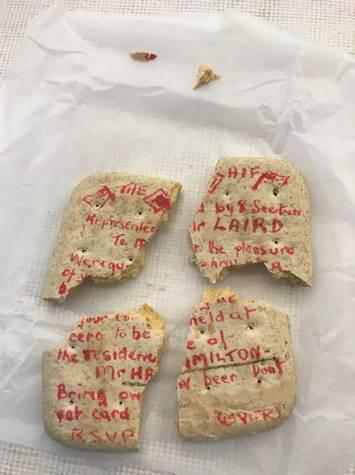What do you do with a broken biscuit?
The Objects Lab at the Australian War Memorial looks after a broad variety of materials, including food. The Memorial’s food collection ranges from Boer War chocolates to conflict ration packs from recent conflicts. For the most part the food itself is intact and well preserved, due to tins and packets being well sealed. However, we consistently monitor the state of food and its interaction with packaging to identify any deterioration. We recently reported on the condition of all 279 foodstuffs in our collection, and along the way found some objects in much need of conservation work. This provided an excellent opportunity to better understand this collection, develop an improved preservation plan, and improve our treatment skills.
The treatment of a Second World War biscuit demonstrates the skills and techniques used by the objects lab. A relic from New Guinea during the Second World War, the biscuit doubles as an invitation to a buck’s party. Red ink writing invites soldiers to a party at the home of “Mr. Hamilton”, instructing the recipient to “bring your own beer” and not to eat the “card”. As well as being an excellent example of a biscuit from this period, a significant part of its story is presented by this writing, demonstrating how biscuits were used. Unfortunately the biscuit had been damaged during its storage life. Although previous treatment to reinforce existing cracks was completed, the result was an unstable, broken biscuit left unreadable and at risk of further damage.
In order for the biscuit to retain its significance and be kept safe from further risk, remedial treatment was undertaken to repair it. Due to their high preservative content, biscuits are amongst some of the better condition food objects in the collection. However working with food brings challenges, as food items are not made for the kind of long-term durability we aim for, and are inherently perishable. In this instance our challenge was to find an adhesive that could be used on an uneven and porous surface, and which would dry clear and matte, so that the repair was undetectable. Carboxymethyl cellulose, which used in conservation as an adhesive or filler, as well as being used as a thickener in foods such as ice-cream and edible glue for fondant decoration, fit the criteria. A 1% mixture was made up with deionized water and carefully painted onto a surface of the cracked biscuit, which was pressed against its corresponding piece, and then fully contained in weights in order to cure with some slight pressure. The materials responded well to the adhesive and the repair is practically undetectable. The reassembled biscuit looks like it had never been broken, and now has improved stability. The biscuit will be stored in one of our environmentally-controlled stores, along with other biscuits in the collection. The success of this treatment will influence future similar treatments, as an example of what to do when similar damage is found.


